| 1. ROMÂNIA |
|---|
| Continued from "Rome and Romania," "Romanians" |
|---|
| WALLACHIA |
MOLDAVIA |
|---|
| Radu Mihnea |
Voivode,
Prince,
Governor,
1611-1616,
1623-1626 |
| Leon Tomsa |
1629-1632 |
Miron
Barnovschi
Movila |
Voivode,
Prince,
Governor,
1626-1629,
1633 |
| Matei Basarab |
1632-1654 |
Vasie Lupu |
1634-1653 |
Constantine
Serban |
1654-1658 |
| Grigore Ghica |
1660-1664 |
Serban
Cantacuzino |
1678-1688 |
Constantine
Brancoveeanu |
1688-1714 |
Constantine
Cantemir |
1685-1693 |
| Phanariot Greek Tax Farming |
|---|
1716-1717,
1719-1730 |
Nicholas Mavrocordat |
1711-1714 |
| | Stephen
Cantacuzino |
1714-1716 |
| 1741-1744 |
Michael Racovita |
1717-? |
1735-1741,
1744-1748 | |
Gregoy Ghica |
1726-1733,
1774-1777 |
| Constantine Mavrocordat |
1741-1743,
?-1769 |
Russian
right of intervention,
Treaty of Kuchuk
Karinarji, 1774 |
|---|
Alexander
Ypsilanti |
1774-1782 |
Alexander
Moruzi |
?-1806 |
Constantine
Ypsilanti |
1802-1806 |
|
Russian
Occupation, 1806-1812 |
|---|
| John Caragea |
1812-1818 |
Scarlat Calimah |
1812-1819 |
| Alexander Sutu |
1818-1821 |
Russian
Occupation, 1828-1834;
Governor Count Kisselev |
|---|
| Alexander Ghica |
1834-1842 |
Mihai Sturdza |
1834-1849 |
| Georghe Bibescu |
1842-1848 |
Revolution
in Wallachia, 1848;
Russian Occupation, 1848-1851;
Crimean War, 1853-1856;
Russian Occupation, 1853-1854;
Austrian Occupation, 1854-1857 |
|---|
| Alexander John Cuza of Moldavia |
1859-1866 |
Charles Eitel Frederick
of Hohenzollern-Sigmaringen,
Carol I |
1866-1881 |
King,
1881-1914 |
Russo-Turkish War, 1876-1878;
Russian Invasion, Romania proclaimed
independent, 1877;
Congress of Berlin, Romania Independent, 1878 |
|---|
| Ferdinand |
1914-1927 |
| Michael |
1927-1930,
1940-1947 |
| Carol II |
1930-1940 |
| Ion Antonescu, pro-German dictator |
1940-1944 |
|
Communist takeover, 1947 |
|---|
| Constantin Parhon |
President, 1948-1952 |
| Petru Groza |
1952-1958 |
| Ion Georghe Maurer |
1958-1961 |
| Georghe Georghiu-Dej |
1961-1965 |
| Chivu Stoica |
1965-1967 |
| Nicolae Ceauçescu |
1967-1989, executed |
| Ion Iliescu |
1989-1996, 2000-present |
| Emil Constantinescu |
1996-2000 |
The Principalities of Wallachia and Moldavia have a continuous institutional history back to the 14th Century, which means that this table simply continues the table begun on the
Rome and Romania page.
 Turkish rule, however, led to the practice of the appointment of Greek tax farmers, the Phanariots (from the Phanar section of Istanbul), as Princes. Their job was simply to get as much money out of the land as possible, both for the Sublime Porte (the Ottoman government) and for themselves (the reason to be a tax farmer). This was not good, or popular, for the Principalities, but not much could be done about it until Russian power began to be felt in the region. The Russian wars against Turkey in the 19th Century led several times to the occupation of Wallachia and Moldavia. After the Crimean War (18453-1856) and, for a change, Austrian occupation (1854-1857), and a bad experience with a local candidate for rule of the unified country, a European prince, as in Greece and Bulgaria,
Turkish rule, however, led to the practice of the appointment of Greek tax farmers, the Phanariots (from the Phanar section of Istanbul), as Princes. Their job was simply to get as much money out of the land as possible, both for the Sublime Porte (the Ottoman government) and for themselves (the reason to be a tax farmer). This was not good, or popular, for the Principalities, but not much could be done about it until Russian power began to be felt in the region. The Russian wars against Turkey in the 19th Century led several times to the occupation of Wallachia and Moldavia. After the Crimean War (18453-1856) and, for a change, Austrian occupation (1854-1857), and a bad experience with a local candidate for rule of the unified country, a European prince, as in Greece and Bulgaria,
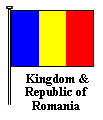 was brought in, Karl of Hohenzollern. The Congress of Berlin recognized Karl (Carol) and Romanian independence (1878). With the Allies in World War I, winning Transylvania from Hungary and Moldova from Russia -- Romania was the biggest long term winner of the War in the Balkans -- Romania, after much internal strife, switched to the Axis in World War II, losing Moldova to the Soviet Union (seized in 1940, actually, before Romania was a belligerent) and part of Dobruja to Bulgaria. While Moldova is now independent, I have not noticed any discussion of reunion with Romania.
was brought in, Karl of Hohenzollern. The Congress of Berlin recognized Karl (Carol) and Romanian independence (1878). With the Allies in World War I, winning Transylvania from Hungary and Moldova from Russia -- Romania was the biggest long term winner of the War in the Balkans -- Romania, after much internal strife, switched to the Axis in World War II, losing Moldova to the Soviet Union (seized in 1940, actually, before Romania was a belligerent) and part of Dobruja to Bulgaria. While Moldova is now independent, I have not noticed any discussion of reunion with Romania.
Rejecting the Cyrllic alphabet and the Turkish influenced "Rumania" (or
"Roumania") for
 the Latin alphabet and the pure Latin România, Romania can now claim that name as its own, with few remembering that it was the proper name of the Roman (and the "Byzantine") Empire. In the Middle Ages, "Romania" tended to refer to the contemporaneous extent of the Empire, i.e. Anatolia and the Balkans ("Asia and
Europa" or "Rûm and Rumelia"). The modern state might be said to be "Lesser Romania" in contrast to that "Greater Romania"; but this might be considered insulting by Romanians
and so is not likely to catch on.
the Latin alphabet and the pure Latin România, Romania can now claim that name as its own, with few remembering that it was the proper name of the Roman (and the "Byzantine") Empire. In the Middle Ages, "Romania" tended to refer to the contemporaneous extent of the Empire, i.e. Anatolia and the Balkans ("Asia and
Europa" or "Rûm and Rumelia"). The modern state might be said to be "Lesser Romania" in contrast to that "Greater Romania"; but this might be considered insulting by Romanians
and so is not likely to catch on.
The mysterious history of Romance speakers in the Balkans, the Romanians and
Vlachs, whose existence is not noticed until the 12th Century and whose language is not attested until the 16th, is treated separated in "The Vlach Connection and Further Reflections on Roman History." This is a story now charged with the nationalism both of Romania and neighbors like Hungary.
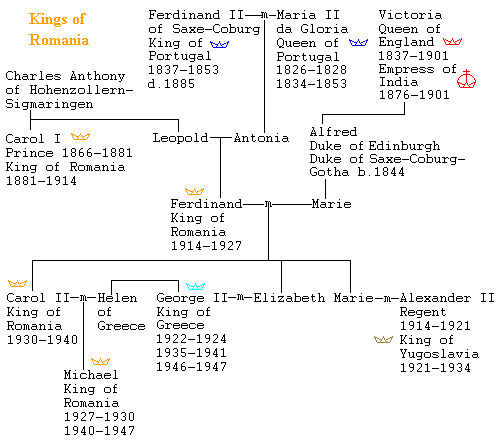 The marriages of the Romanian Royal Family quickly connected it to major European, especially British and Greek, royalty. Thus King Ferdinand was the grandson of a first cousin of Queen Victoria and Prince Albert (Ferdinand of Portugal, the brother of Augustus, Prince of
Coburg, who was the father of Ferdinand of Bulgaria), and he married one of their own granddaughters, Marie of Saxe-Coburg-Gotha. King Carol II then married Helen of Greece, who was a great-granddaughter of Queen Victoria, through her mother Sophia, the sister of Kaiser Wilhlem II of Germany. All these connections, of course, profited the monarchy little in the conflicts of fascism and communism that had the country under one form of dictatorship or another from 1940 to 1989.
The marriages of the Romanian Royal Family quickly connected it to major European, especially British and Greek, royalty. Thus King Ferdinand was the grandson of a first cousin of Queen Victoria and Prince Albert (Ferdinand of Portugal, the brother of Augustus, Prince of
Coburg, who was the father of Ferdinand of Bulgaria), and he married one of their own granddaughters, Marie of Saxe-Coburg-Gotha. King Carol II then married Helen of Greece, who was a great-granddaughter of Queen Victoria, through her mother Sophia, the sister of Kaiser Wilhlem II of Germany. All these connections, of course, profited the monarchy little in the conflicts of fascism and communism that had the country under one form of dictatorship or another from 1940 to 1989.
Mediaeval România
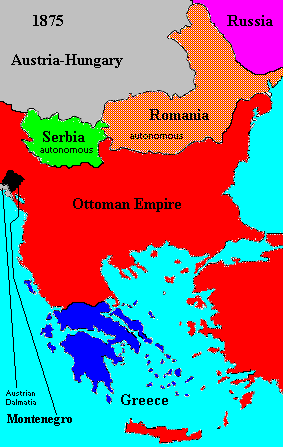
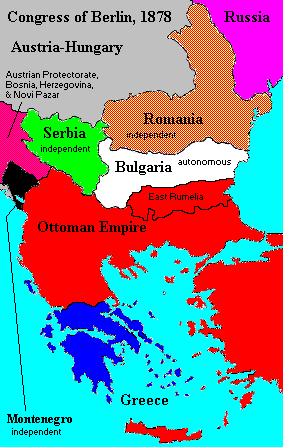
The two maps above show the situation before and after the Russo-Turkish War of 1877-1878. Note that by then Britain had ceded the Ionians Islands to Greece (1864). In 1875 rebellions started in Bosnia and then Bulgaria. The brutality with which these were suppressed aroused European opinion, and after some delay Russia declared war. With some hard fighting, the Russians ended up capturing Adrianople and arriving at the outskirts of Constantinople. The Treaty of San Stephano which ended the war mostly freed the Balkans, but the Great Powers didn't like it. The Congress of Berlin rolled things back a bit. Serbia, România, and Montenegro all became independent, with increases in territory, but Bulgaria was divided and merely allowed autonomy. Bosnia, Herzegovina, and Novipazar were made protectorates of Austria. The map looked much the same for many years, with Bulgaria annexing East Rumelia in 1885.


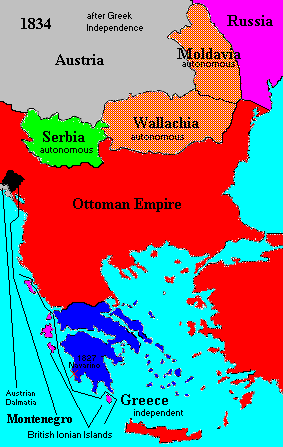
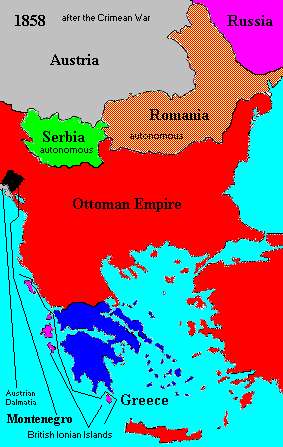
 was brought in, Karl of Hohenzollern. The Congress of Berlin recognized Karl (Carol) and Romanian independence (1878). With the Allies in World War I, winning Transylvania from Hungary and Moldova from Russia -- Romania was the biggest long term winner of the War in the Balkans -- Romania, after much internal strife, switched to the Axis in World War II, losing Moldova to the Soviet Union (seized in 1940, actually, before Romania was a belligerent) and part of Dobruja to Bulgaria. While Moldova is now independent, I have not noticed any discussion of reunion with Romania.
was brought in, Karl of Hohenzollern. The Congress of Berlin recognized Karl (Carol) and Romanian independence (1878). With the Allies in World War I, winning Transylvania from Hungary and Moldova from Russia -- Romania was the biggest long term winner of the War in the Balkans -- Romania, after much internal strife, switched to the Axis in World War II, losing Moldova to the Soviet Union (seized in 1940, actually, before Romania was a belligerent) and part of Dobruja to Bulgaria. While Moldova is now independent, I have not noticed any discussion of reunion with Romania.
 The marriages of the Romanian Royal Family quickly connected it to major European, especially British and Greek, royalty. Thus King Ferdinand was the grandson of a first cousin of Queen Victoria and Prince Albert (Ferdinand of Portugal, the brother of Augustus, Prince of
Coburg, who was the father of Ferdinand of
The marriages of the Romanian Royal Family quickly connected it to major European, especially British and Greek, royalty. Thus King Ferdinand was the grandson of a first cousin of Queen Victoria and Prince Albert (Ferdinand of Portugal, the brother of Augustus, Prince of
Coburg, who was the father of Ferdinand of 

